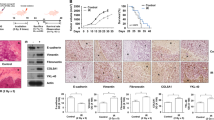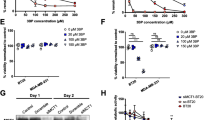Abstract
Purpose
Breast cancer is the most common type of cancer with high incidence in women. Currently, identifying new therapies that selectively inhibit tumor growth without damaging normal tissue are a major challenge of cancer research. One of the features of cancer cells is that they do not consume more oxygen even under normal oxygen circumstances but prefer to aerobic glycolysis through the enhanced catabolism of glucose and glutamine. In this study, we investigate the mechanisms of the radioresistance in breast cancer cells.
Methods
Human breast cancer cells MDA-MB-231 and MCF-7 were treated with radiation alone, Glut1 inhibitor alone or the combination of both to evaluate cell glucose metabolism and apoptosis. By the establishment of radioresistant cell line, we investigate the mechanisms of the combined treatments of radiation with Glut1 inhibitor in the radioresistant cells.
Results
The glucose metabolism and the expression of Glut1 are significantly stimulated by radiotherapy. We report the radioresistant breast cancer cells exhibit upregulated Glut1 expression and glucose metabolism. In addition, we observed overexpression of Glut1 renders breast cancer cells resistant to radiation and knocking down of Glut1 sensitizes breast cancer cells to radiation. We treated breast cancer cells with radiation and WZB117 which inhibits Glut1 expression and glucose metabolism and found the combination of WZB117 and radiation exhibits synergistically inhibitory effects on breast cancer cells. Finally, we demonstrate the inhibition of Glut1 re-sensitizes the radioresistant cancer cells to radiation.
Conclusions
This study reveals the roles of Glut1 in the radiosensitivity of human breast cancer. It will provide new mechanisms and strategies for the sensitization of cancer cells to radiotherapy through regulation of glucose metabolism.






Similar content being viewed by others
References
Tinoco G, Warsch S, Glück S, Avancha K, Montero AJ (2013) Treating breast cancer in the 21st century: emerging biological therapies. J Cancer 4:117–132
Sledge GW, Mamounas EP, Hortobagyi GN, Burstein HJ, Goodwin PJ, Wolff AC (2014) Past, present, and future challenges in breast cancer treatment. J Clin Oncol 32:1979–1986
Hassan MS, Ansari J, Spooner D, Hussain SA (2010) Chemotherapy for breast cancer. Oncol Rep 24:1121–1131
Delaney G, Jacob S, Featherstone C, Barton M (2005) The role of radiotherapy in cancer treatment: estimating optimal utilization from a review of evidence-based clinical guidelines. Cancer 104:1129–1137
Jameel JK, Rao VS, Cawkwell L, Drew PJ (2004) Radioresistance in carcinoma of the breast. Breast 13:452–460
Huang EY, Chen YF, Chen YM, Lin IH, Wang CC, Su WH, Chuang PC, Yang KD (2012) A novel radioresistant mechanism of galectin-1 mediated by H-Ras-dependent pathways in cervical cancer cells. Cell Death Dis 3:e251
Harada H, Inoue M, Itasaka S, Hirota K, Morinibu A, Shinomiya K, Zeng L, Ou G, Zhu Y, Yoshimura M, McKenna WG, Muschel RJ, Hiraoka M (2012) Cancer cells that survive radiation therapy acquire HIF-1 activity and translocate towards tumour blood vessels. Nat Commun 3:783
Dang CV (2012) Links between metabolism and cancer. Genes Dev 26:877–890
Ganapathy-Kanniappan S, Geschwind JF (2013) Tumor glycolysis as a target for cancer therapy: progress and prospects. Mol Cancer 12:152
Bhatt AN, Chauhan A, Khanna S, Rai Y, Singh S, Soni R, Kalra N, Dwarakanath BS (2015) Transient elevation of glycolysis confers radio-resistance by facilitating DNA repair in cells. BMC Cancer 15:335
Zhong J, Rajaram N, Brizel DM, Frees AE, Ramanujam N, Batinic-Haberle I, Dewhirst MW (2013) Radiation induces aerobic glycolysis through reactive oxygen species. Radiother Oncol 106:390–396
Liu Y, Cao Y, Zhang W, Bergmeier S, Qian Y, Akbar H, Colvin R, Ding J, Tong L, Wu S, Hines J, Chen X (2012) A small-molecule inhibitor of glucose transporter 1 downregulates glycolysis, induces cell-cycle arrest, and inhibits cancer cell growth in vitro and in vivo. Mol Cancer Ther 11:1672–1682
Shibuya KI, Okada M, Suzuki S, Seino MI, Seino S, Takeda H, Kitanaka C (2015) Targeting the facilitative glucose transporter GLUT1 inhibits the self-renewal and tumor-initiating capacity of cancer stem cells. Oncotarget 6:651–661
Liu W, Fang Y, Wang XT, Liu J, Dan X, Sun LL (2014) Overcoming 5-Fu resistance of colon cells through inhibition of Glut1 by the specific inhibitor WZB117. Asian Pac J Cancer Prev 15:7037–7041
Andrisse S, Koehler RM, Chen JE, Patel GD, Vallurupalli VR, Ratliff BA, Warren DE, Fisher JS (2014) Role of GLUT1 in regulation of reactive oxygen species. Redox Biol 2:764–771
North PE, Waner M, Mizeracki A, Mihm MC Jr (2000) GLUT1: a newly discovered immunohistochemical marker for juvenile hemangiomas. Hum Pathol 31:11–22
Loar P, Wahl H, Kshirsagar M, Gossner G, Griffith K, Liu JR (2010) Inhibition of glycolysis enhances cisplatin-induced apoptosis in ovarian cancer cells. Am J Obstet Gynecol. 202:371.e1-8
Shin YK, Yoo BC, Hong YS, Chang HJ, Jung KH, Jeong SY, Park JG (2009) Upregulation of glycolytic enzymes in proteins secreted from human colon cancer cells with 5-fluorouracil resistance. Electrophoresis 30:2182–2192
Bean JF, Qiu YY, Yu S, Clark S, Chu F, Madonna MB (2014) Glycolysis inhibition and its effect in doxorubicin resistance in neuroblastoma. J Pediatr Surg 49:981–984
Lomax ME, Folkes LK, O’Neill P (2013) Biological consequences of radiation-induced DNA damage: relevance to radiotherapy. Clin Oncol (R Coll Radiol) 25:578–585
Moeller BJ, Cao Y, Li CY, Dewhirst MW (2004) Radiation activates HIF-1 to regulate vascular radiosensitivity in tumors: role of reoxygenation, free radicals, and stress granules. Cancer Cell 5:429–441
Quennet V, Yaromina A, Zips D, Rosner A, Walenta S, Baumann M, Mueller-Klieser W (2006) Tumor lactate content predicts for response to fractionated irradiation of human squamous cell carcinomas in nude mice. Radiother Oncol 81:130–135
Shimura T, Noma N, Sano Y, Ochiai Y, Oikawa T, Fukumoto M, Kunugita N (2014) AKT-mediated enhanced aerobic glycolysis causes acquired radioresistance by human tumor cells. Radiother Oncol 112:302–307
Acknowledgments
The authors thank all the staff and faculty working in Breast Disease Center, Southwest Hospital, Third Military Medical University, Chongqing, China. We thank Dr. Yan Zhou for providing the editorial assistance and Dr. Jia Ming for critical review of the manuscript.
Author contributions
FZH. and L.J.F. designed research; F.ZH., J.M. and L.J.F. developed methodology; F.ZH., J.M. and Y.ZH. performed experiments and acquisition of data; F.ZH., J.M., Y.ZH. and L.J.F analyzed data and F.ZH., J.M. and L.J.F. wrote the paper
Author information
Authors and Affiliations
Corresponding author
Ethics declarations
Conflict of interest
No potential conflicts of interest were disclosed.
Rights and permissions
About this article
Cite this article
Zhao, F., Ming, J., Zhou, Y. et al. Inhibition of Glut1 by WZB117 sensitizes radioresistant breast cancer cells to irradiation. Cancer Chemother Pharmacol 77, 963–972 (2016). https://doi.org/10.1007/s00280-016-3007-9
Received:
Accepted:
Published:
Issue Date:
DOI: https://doi.org/10.1007/s00280-016-3007-9




